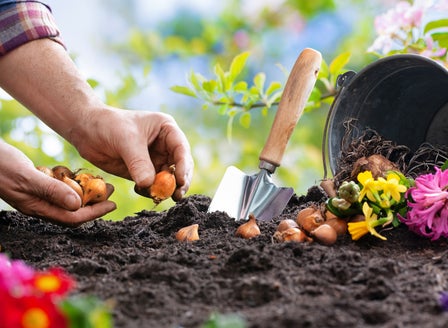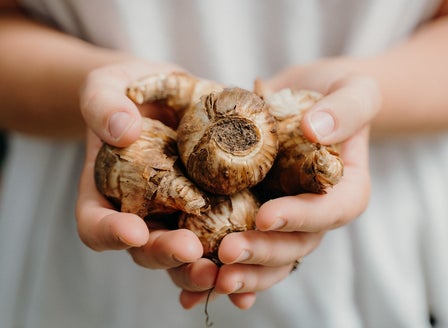Elegant spring blooms, available in an array of colours and flower shapes. When planted en masse they will catch the attention of anyone's eye. Their flowers are varied and showy, brightly coloured, generally red, pink, yellow, or white.
Planting Calendar
Ideally, tulip bulbs should be planted in late Autumn for Spring flowering.
Prepare
Position
Tulips do well both in the ground as well as in pots. Pick a nice sunny spot to plant your bulbs.
Soil
When planted into the ground, tulips like a free draining soil that is rich in organic matter. To improve the organic content in your soil, break up the soil and add Kings Compost and Kings Sheep Pellets then mix together well. If planting into a pot, plant in a free-draining mix without water storage crystals such as Tui Bulb Mix or Kings Potting Mix.
Plant
In the ground. Leave between 10-15cm between each bulb, and plant to a depth of 6-8cm. Water them in thoroughly after planting with Aquaticus Garden Booster added to the water. In Containers: Situate your container or pot in full sun. Use Tui Bulb Mix or Kings Potting Mix. In larger pots leave between 10-15cm between each bulb and plant to a depth of 6-8cm deep. Water them in thoroughly after planting with Aquaticus Garden Booster added to the water.
Care
Watering
Once established, tulips do not require too much attention. Water regularly just enough to keep soil moist, but not water logged. Never allow the pot to sit in any water.
Feeding
Apply Kings Slow Release Bulb Food when first planting and once again after the first signs of bud formation. For a natural option apply Kings Sheep Pellets to the surface of the soil after planting and liquid feed with Aquaticus Organic Garden Booster once they start to grow.
Protecting
The most likely pest for tulips is by snails and slugs. Sprinkle appropriate snail and slug bait around plants. If you have pets ensure you use Quash as it is pet friendly.
General Care
AFTER FLOWERING Tulips can go to seed if the flowers are not dead headed. Remove the flowers and allow the foliage to die back naturally. Bulbs draw the nutrients from the leaves and store them for next season. Removing the leaves too early may result in poor quality flowering the following year. Most bulbs can be left in the ground for many years, and don’t need to be lifted unless they become overcrowded or if they need extra winter chilling. Usually, tulip bulbs lose their flowering vigour after three years due to overcrowding. Lift them up, dry them for a few weeks and separate the clumps. Then dust them with flowers of sulphur to prevent any fungal infection in storage. These can be planted the following season.
Beginner Tip
Tulip bulbs are best lifted in November-December and should be put in a fridge 6 weeks before you are ready to plant them again in April-May.
Expert Tip
If you live in a warmer area of the country, you should chill your tulips for six weeks prior to planting so that the bud can complete its development and to ensure the plants have nice, long stems. Put the bulbs in the fridge in a paper bag but keep them away from your fruit and veggies that produce the ripening gas ethylene, such as apples and bananas, which can prevent flower and root formation.
Tip
When using sprays, chemicals or fertilisers always read the label and follow the instructions. Apply sprays in the evening to avoid harming beneficial insects.
Top Varieties
Apeldoorn
Gorgeous, long lasting cherry red bloom. Flowers mid-late spring.
Queen of the Night
Add drama to your garden with these dark red and majestic flowers.
White Dream
Stunning ivory white goblets on long sturdy stems.
Lily Schreyer
Their warm, bold flowers are a beautiful golden yellow that are sure to warm your heart after the mild dampness of winter.
Frequently Asked Questions
When is the best time to plant tulip bulbs?
The best time to plant tulip bulbs is during the cooler months of April and May. This allows the bulbs to establish roots before the warmer weather arrives.
How should I plant tulip bulbs?
In the ground leave between 10-15cm between each bulb, and plant to a depth of 6-8cm. Water them in thoroughly after planting with Aquaticus Garden Booster added to the water.
How often should I water my tulips?
Once established, tulips do not require too much attention. Water regularly just enough to keep soil moist, but not water logged. Never allow the pot to sit in any water.
How can I protect my tulips from pests and diseases?
Slugs and snails can be a problem for tulips. Use slug pellets or traps to protect your plants. Good air circulation and well-drained soil help prevent fungal diseases.
When do tulips bloom in Auckland?
Tulips typically bloom in Auckland from late September to early November, depending on the variety and weather conditions.

